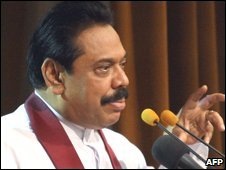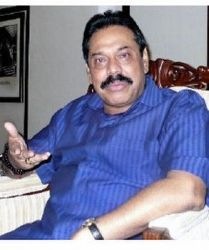 ‘Every square centimetre has been mined by the LTTE and de-mining has to be certified by the U.N. If something happens, I am responsible.’
‘Every square centimetre has been mined by the LTTE and de-mining has to be certified by the U.N. If something happens, I am responsible.’
President Mahinda Rajapaksa highlighted his determination to re-settle “as soon as possible” the close to 300,000 Tamil civilians displaced by the conflict with the LTTE. In an extended interview given to The Hindu in Colombo, he laid out his road map of what needed to be put in place to ensure the safety and meet the basic needs of those who are to be sent back to their villages. He also sketched his vision of reconciliation and development, which emphasised that in post-conflict Sri Lanka there was no place for “racism” and anything that “creates a disturbance among our three communities…Sinhala, Tamil, or Muslim.”
“I would say the condition in our camps is the best any country has,” the Sri Lankan President told me in a two-and-a-half-hour interview and conversation over dinner at Temple Trees, the former official residence of Prime Ministers, on June 30. Basic needs, including schooling for the children, were being met. He suggested that I visit the Vavuniya IDP camps the next day, which I was able to do thanks to the arrangements made overnight, on his instructions, by the Defence Ministry.
“We know there are shortcomings,” President Rajapaksa observed. “Slowly, we have to overcome them. In some camps there are no problems.” Revealing that he did not rely on “information only from officials” and that he had sent “some people close to me to the camps,” he said his reliable sources told him that the displaced Tamils were “satisfied with the housing and shelter” but their real problem was the lack of “freedom of movement.”
 Since there were security concerns, the President reflected, “I don’t know how to do that immediately.” De-mining had to be completed, and certified by the United Nations, in a region where “every square centimetre has been mined by the LTTE” and “if something happens, I am responsible.”
Since there were security concerns, the President reflected, “I don’t know how to do that immediately.” De-mining had to be completed, and certified by the United Nations, in a region where “every square centimetre has been mined by the LTTE” and “if something happens, I am responsible.”
Further, he pointed out, “I can’t send them to a place without basic facilities. Now we’re spending on electricity, on roads, on water. We can’t send them back to a place where there are just jungles.”
On May 21, two days after the military operations against the LTTE ended, Mr. Rajapaksa announced a 180-day resettlement plan. The participation on July 2 of 22 parties, including the Tamil National Alliance, in the first meeting of the newly constituted All Party Committee on Development and Reconciliation, and their assurances of cooperation and support to the President in this ambitious project, has strengthened the government’s confidence and raised hope all round that the rehabilitation process will be fast-tracked and implemented smoothly.
Asked about the political solution – the “13th Amendment Plus” – he had in mind, President Rajapaksa said “even tomorrow I can give that – but I want to get that from the people.” He insisted that all parties, and especially the Tamil National Alliance representatives, should participate in the discussions on the political solution. “I am waiting but it will be after my [re]election [as President],” which, according to some political observers, may come as early as November 2009.
Responding to further questions on a political solution to the ethnic problem, Mr. Rajapaksa said: “I know what to give and I know what not to give. The people have given me the mandate, so I’m going to use it. But I must get these people [the TNA representatives] to agree to this. They must also know that they can’t get what they want. No way for federalism in this country. For reconciliation to happen, there must be a mix [of ethnicities].”
The Sri Lankan President reiterated his belief in “my theory…[that] there are no minorities in Sri Lanka, there are only those who love the country and those who don’t. They tried to twist that but I still maintain that position.”
In the second and third parts of the interview, which are to follow, President Rajapaksa provides his assessment of the LTTE’s character and capabilities, its military strengths, weaknesses, and final strategy. He provides new insights into his own approach to the peace process and explains what led to the successful military offensive, which “did not come without negotiation or without any reason.” He also answers questions about ‘triumphalism,’ the ‘too-powerful presidency,’ pressures on media freedom, Indo-Sri Lanka relations, and India’s response to the dramatic developments in the island nation.
(For updates you can share with your friends, follow TNN on Facebook and Twitter )
